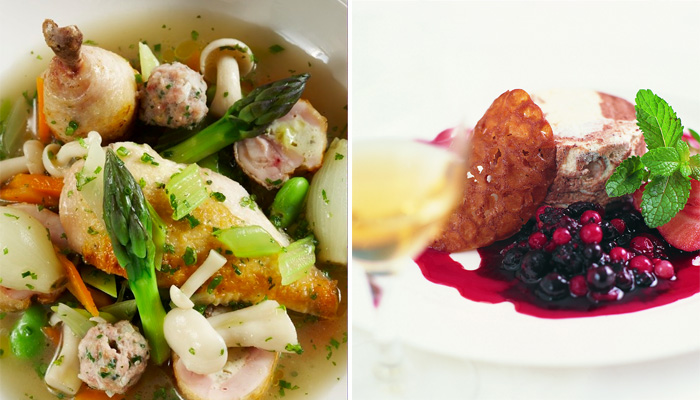Food and Wine Matching Basics
Author: Katie Rolph
Match the weight of the food to the weight of the wine. Full-bodied wines complement heavy, rich foods so that neither overshadows the other.
Match the flavour intensity of both (e.g. rich/intense flavours like Sauvignon Blanc and asparagus, mild flavours like Chablis and shellfish) and also consider the wine’s fruit character (the raspberry flavours in Pinot Noir complement duck the same way a delicious fruit sauce would).
Match acidity in wine and food. Wines with higher levels of acidity come from cool climate regions – the hotter the climate, the riper the grapes will get and therefore their sugar levels rise. So if you were looking for a perfect accompaniment to fruits de mers think of cool climate wines, e.g. Muscadet-sur-Lie or Chablis – both wines from cool climate regions in northern France.
Alternatively consider that high-acid wines complement fatty foods the same way lemon cuts the greasiness of smoked salmon.
The more textured the food (e.g. fatty like duck, chewy like steak) the more tannin you need in the wine because protein tempers the effect of the tannin. This is why wines from tannic grape varieties, such as Cabernet Sauvignon or Syrah, go well with roasted red meat and casseroles. Light, fruity red wines with low amounts of tannin, like Beaujolais and Bardolino, complement light meats such as veal and chicken.
Salty foods are enhanced by a touch of sweetness (e.g. prosciutto and melon). Salty foods are also balanced by a bit of acidity. An excellent match for salty nibbles like olives and nuts is a Manzanilla or Fino Sherry. Avoid tannic wines as salt brings out the bitterness in tannins. Crisp, low-tannin reds that can be chilled (Beaujolais, Loire reds) work well.
Dry wines will seem tart and overly acidic when drunk alongside any sweet food so serve a wine with greater sweetness than the food. Sweetness in wine also acts as a foil to rich foods (Sauternes works brilliantly with foie gras because the weight and richness of both are similar, and the wine’s acidity cuts through the foie gras’ fattiness).
Finally, if all else fails, matching a local dish to a wine from the same region will rarely go wrong as the combinations have evolved successfully over time (for example, grilled sardines and Vinho Verde or steak and Argentinean Malbec).
So, armed with this extra food and wine matching knowledge the best way forward is to start experimenting. Below is a recent Wine Club recipe for Moroccan Braised Pork Cheeks that we paired with 2007 Nolan Cabernet Sauvignon, from Wrattonbully, South Australia.
Stuart says: ‘This Cabernet Sauvignon would be delicious with braised pork cheeks, a robust dish but one that is lightly spiced with cumin and cinnamon. That will really hit home with those spicy and savoury notes in the wine.’
Moroccan Braised Pork Cheeks
Serves 8
In the winter months you can’t beat a good stew and I am very partial to this sort of comfort dish. The key to a good one is the cut of meat you use. In the supermarket I often see packets of braising steak that are a dice of lean meat, normally from the top or silverside. They don’t have much, if any, fat so therefore are unsuitable for slow cooking because very lean meat becomes dry and chalky with a long cooking time. So remember: when braising, fat is your friend! My preferred cut is the cheek- a great cut of pure meat with natural marbling that becomes very tender and gelatinous with long, slow cooking keeping the meat lovely and moist.
Ingredients
32 pork cheeks, trimmed of all sinew
Salt and freshly ground pepper
2 tsp ground coriander
2 tsp ground cumin
2 tsp ground cinnamon
½ tsp strands saffron
2 tbsp olive oil
4 cloves garlic
2 onion, chopped
2 carrot, chopped
2 sticks celery
5 sprigs fresh thyme, leaves picked and chopped
250ml ginger beer
20 dried apricots, pitted
1 litre chicken stock
Method
Place the pork cheeks in a bowl, drizzle with olive oil and sprinkle with the ground spices and saffron then marinate for about 4 to 5 hours. Remove the cheeks from the fridge at least 30 minutes before cooking and season with salt and pepper.
Preheat the oven 160ºC. Heat a large oven proof casserole. Add a splash of olive oil and fry the cheeks until well browned on all sides, remove from the pan and set aside. Return the casserole to the heat and add another splash of oil, fry the vegetables with the thyme and garlic until nice and golden.
Pour in the ginger beer and cook until the liquid has reduced by two thirds then add the chicken stock, bring to the boil and skim. Return the browned cheeks to the pan, cover with a lid and braise in the oven for about 1 hour 30mins until they are meltingly tender.
Remove the cheeks and vegetables from the pan and place in a serving dish, set aside and keep warm then reduce the braising liquid to a nice saucy consistency.
Pour the sauce back over the cheeks and finish with a scattering of dried apricots. Serve with some spiced couscous and winter greens.
Katie Cooper, Wine Club Manager



